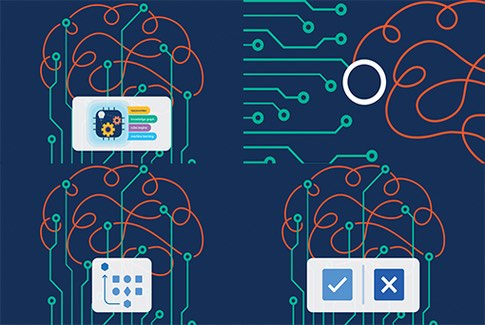
How do you know if natural language process (NLP) is effective? This is a key concern for NLP practitioners responsible for the ROI and accuracy of their NLP programs. These professionals want better NLP outcomes faster. You can proactively get ahead of NLP problems by improving machine language understanding. That’s where semantic analysis can help.
A system for semantic analysis determines the meaning of words in text. Semantics gives a deeper understanding of the text in sources such as a blog post, comments in a forum, documents, group chat applications, chatbots, etc. With lexical semantics, the study of word meanings, semantic analysis provides a deeper understanding of unstructured text. This unstructured text is critical to gaining business insight.
How Does Semantic Analysis Work?
Semantic analysis starts with lexical semantics, which studies individual words’ meanings (i.e., dictionary definitions). Semantic analysis then examines relationships between individual words and analyzes the meaning of words that come together to form a sentence. This analysis provides a clear understanding of words in context. For example, it provides context to understand the following sentences:
- “The boy ate the apple” defines an apple as a fruit.
- “The boy went to Apple” defines Apple as a brand or store.
The NLP Problem Solved by Semantic Analysis
As discussed in previous articles, NLP cannot decipher ambiguous words, which are words that can have more than one meaning in different contexts. Semantic analysis is key to contextualization that helps disambiguate language data so text-based NLP applications can be more accurate. Let’s dive deeper into why disambiguation is crucial to NLP.
Machines lack a reference system to understand the meaning of words, sentences and documents. Word sense disambiguation and meaning recognition can provide a better understanding of language data for machines. Here is how each part of semantic analysis works:
- Lexical analysis is the process of reading a stream of characters, identifying the lexemes and converting them into tokens that machines can read.
- Grammatical analysis correlates the sequence of lexemes (words) and applies formal grammar to them so part-of-speech tagging can occur.
- Syntactical analysis analyzes or parses the syntax and applies grammar rules to provide context to meaning at the word and sentence level.
- Semantic analysis uses all of the above to understand the meaning of words and interpret sentence structure so machines can understand language as humans do.
Why Is Semantic Analysis Important to NLP?
Language data is a rich source of business intelligence. However, many organizations struggle to capitalize on it because of their inability to analyze unstructured data. This challenge is a frequent roadblock for artificial intelligence (AI) initiatives that tackle language-intensive processes.
Every type of communication — be it a tweet, LinkedIn post, or review in the comments section of a website — may contain potentially relevant and even valuable information that companies must capture and understand to stay ahead of their competition. Capturing the information is the easy part but understanding what is being said (and doing this at scale) is a whole different story.
To understand how NLP and semantic processing work together, consider this:
- Basic NLP can identify words from a selection of text.
- Semantics gives meaning to those words in context (e.g., knowing an apple as a fruit rather than a company).
Semantics Makes Word Meaning Clear
The way humans understand what’s being said is almost an unconscious process using a neural network. To understand what a text is talking about, we rely on what we already know about language itself and the concepts present in the text. Machines cannot rely on these same techniques.
Some technologies only make you think they understand text. For instance, an approach based on keywords, computational linguistics or statistical NLP (perhaps even pure machine learning) likely uses a matching or frequency technique with clues as to what a text is “about.” These methods can only go so far because they are not looking to understand the meaning.
Semantic analysis, on the other hand, is crucial to achieving a high level of accuracy when analyzing text.
Consider the task of text summarization which is used to create digestible chunks of information from large quantities of text. Text summarization extracts words, phrases, and sentences to form a text summary that can be more easily consumed. The accuracy of the summary depends on a machine’s ability to understand language data.
Semantic Analysis Is Part of a Semantic System
A semantic system brings entities, concepts, relations and predicates together to provide more context to language so machines can understand text data with more accuracy. Semantic analysis derives meaning from language and lays the foundation for a semantic system to help machines interpret meaning.
To better understand this, consider the following elements of semantic analysis that help support language understanding:
- Hyponymy: A generic term.
- Homonymy: Two or more lexical terms with the same spelling and different meanings.
- Polysemy: Two or more terms that have the same spelling and similar meanings.
- Synonymy: Two or more lexical terms with different spellings and similar meanings.
- Antonymy: A pair of lexical terms with contrasting meanings.
- Meronomy: A relationship between a lexical term and a larger entity.
Understanding these terms is crucial to NLP programs that seek to draw insight from textual information, extract information and provide data. It is also essential for automated processing and question-answer systems like chatbots.
Ease Semantic Analysis With Cognitive Platforms
Semantic analysis describes the process of machines understanding natural language as humans do based on meaning and context. Cognitive technology like that offered by expert.ai eases this process. How, you ask?
Expert.ai’s rule-based technology starts by reading all of the words within a piece of content to capture its real meaning. It then identifies the textual elements and assigns them to their logical and grammatical roles. Finally, it analyzes the surrounding text and text structure to accurately determine the proper meaning of the words in context.
As a result of this process, you can identify the most relevant elements in text and determine the primary topic being discussed. You can also understand the relationships between different concepts in the text. For example, you can understand text to be about politics and economics, even if it doesn’t contain those actual words, by the context of related concepts such as “election,” “Democrat,” or “inflation.”
This degree of language understanding can help companies automate even the most complex language-intensive processes and, in doing so, transform the way they do business. So the question is, why settle for an educated guess when you can rely on actual knowledge? With semantic analysis, you don’t.
Originally published November 2017, updated April 2022


